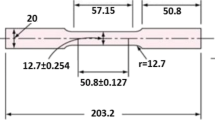Abstract
With the increase of government regulation, pressure to reduce environmental impact, fuel consumption, and safety improvements, the steelmaking industry has developed Advanced High-Strength Steels. However, the application of these steels depends on the knowledge of mechanical properties and parameters of the forming processes. Forming limit curve (FLC) is an important tool used to evaluate the formability of sheet metal. The aim of this study is to modify and analyze the Banabic method to the standards of DIN EN ISO 12004-2 and then comparing it to the Nakazima test using first generation Dual-phase 600. For this purpose, numerical simulations with experimental data verification, the differences of both methods were performed. Based on finite element simulations the adapted Banabic method resulted in uniform punch force and strain profile than Nakazima specimens. The Banabic test method provides greater strain, stress distribution and maximum strain values closer to the punch pole in their specimens. Therefore, modified Banabic method has advantages over the Nakazima test, as to induce a fracture behavior closer to the punch pole in the same friction conditions and easier machining of specimens.

















Similar content being viewed by others
References
Roy, T.K., Bhattacharya, B., Ghosh, C., Ajmani, S.K.: Advanced high Strength Steel. Springer Nature Singapore Pte Ltd, New York (2018)
Keeler, S., Kimchi, M.: Advanced High-Strength Steels Application Guidelines Version 6.0. 3S-Superior Stam** Solutions. LLC., WorldAutoSteel, 1–17. (2017)
Demeri, M.Y.: Advanced high-strength Steels: Science, Technology, and Applications. ASM international (2013)
Marcondes, P.V.P., dos Santos, R.A., Haus, S.A.: The coining force influence on springback in TRIP800 steel V and L-bending processes. J. Brazilian Soc. Mech. Sci. Eng. 38(2), 455–463 (2016)
Ashby, M.F., Jones, D.R.: Engineering Materials 1: An Introduction to Properties, Applications and Design, vol. 1. Elsevier (2011)
Giansoldati, M., Monte, A., Scorrano, M.: Barriers to the adoption of electric cars: evidence from an italian survey. Energy Policy. 146, 111812 (2020)
Stahl, W.W., Bućko, P.: Analysis of the impact of charging electric cars on the power system load.Acta Energetica. (2019)
Harlow, S.: Lithium war heats up after epic launch of tesla model. Oilprice.com. London, 19 abr. (2016)
Kuziak, R., Kawalla, R., Waengler, S.: Advanced high strength steels for automotive industry. Archives of civil and mechanical engineering. 8(2), 103–117 (2008)
Soleimani, M., Mirzadeh, H., Dehghanian, C.: Processing route effects on the mechanical and corrosion properties of dual phase steel. Met. Mater. Int. 26(6), 882–890 (2020)
Tasan, C.C., Diehl, M., Yan, D., Bechtold, M., Roters, F., Schemmann, L., Zheng, C., Peranio, N., Ponge, D., Koyama, M., Tsuzaki, K.: An overview of dual-phase steels: advances in microstructure-oriented processing and micromechanically guided design. Annu. Rev. Mater. Sci. 45, 391–431 (2015)
Nikhare, C., Hodgson, P.D., Weiss, M.: Necking and fracture of advanced high strength steels. Mater. Sci. Engineering: A. 528(6), 3010–3013 (2011)
Waterschoot, T., Verbeken, K., BC, D.C.: Tempering kinetics of the martensitic phase in DP steel. ISIJ Int. 46(1), 138–146 (2006)
Panich, S., Barlat, F., Uthaisangsuk, V., Suranuntchai, S., Jirathearanat, S.: Experimental and theoretical formability analysis using strain and stress based forming limit diagram for advanced high strength steels. Mater. Design. 51, 756–766 (2013)
Abspoel, M., Scholting, M.E., Droog, J.M.: A new method for predicting forming limit curves from mechanical properties. J. Mater. Process. Technol. 213(5), 759–769 (2013)
Banabic, D., Lazarescu, L., Paraianu, L., Ciobanu, I., Nicodim, I., Comsa, D.S.: Development of a new procedure for the experimental determination of the forming limit curves. CIRP Ann. 62(1), 255–258 (2013)
Keeler, S.P.: Plastic instability and fracture in sheets stretched over rigid punches (Doctoral dissertation, Massachusetts Institute of Technology). (1961)
Goodwin, G.M.: Application of strain analysis to sheet metal forming problems in the press shop.Sae Transactions,380–387. (1968)
Gipiela, M.L., Fabris, A., Marcondes, P.V.P.: Influencia da força do prensa-chapas na Conformabilidade do aço multifásico CPW 800. Congresso Nacional De Engenharia Mecânica,Uberlândia (2014)
Hecker, S.: Formability of aluminum alloy sheets. J. Eng. Mater. Technol. v. 97(1), 66–73 (1975)
Brazilian Technical Standards Association. NBR 6673: Produtos Planos de Aço—Determinação das Propriedades Mecânicas a Tração. (1981)
ISO, D.: Metallic materials-Sheet and strip-Determination of forming-limit curves-Part 2: Determination of forming-limit curves in the laboratory. ISO. (2008)
Chemin Filho, R.A.: Estudo da fratura de aços de nova geração DP600 através da variação de pressão no prensa-chapas. (2011)
Madi, M., Júnior, M.V., Marcondes, P.V.P.: An analysis of the forming speed variation with relation to deep drawing depth of steel DP 600 sheets. Int. J. Adv. Manuf. Technol. 99(9), 2417–2424 (2018)
Valente Tigrinho, L.M., Filho, C., R. A., Prestes Marcondes, P.V.: Fracture analysis approach of DP600 steel when subjected to different stress/strain states during deformation. Int. J. Adv. Manuf. Technol. 69(5), 1017–1024 (2013)
Author information
Authors and Affiliations
Corresponding author
Additional information
Publisher’s note
Springer Nature remains neutral with regard to jurisdictional claims in published maps and institutional affiliations.
Electronic supplementary material
Below is the link to the electronic supplementary material.
Rights and permissions
Springer Nature or its licensor (e.g. a society or other partner) holds exclusive rights to this article under a publishing agreement with the author(s) or other rightsholder(s); author self-archiving of the accepted manuscript version of this article is solely governed by the terms of such publishing agreement and applicable law.
About this article
Cite this article
De Araujo Bornancin, R.M., Nikhare, C.P. & Marcondes, P.V.P. Numerical comparison of advanced high strength steels forming limit curve using Banabic and Nakazima tests. Int J Interact Des Manuf (2023). https://doi.org/10.1007/s12008-023-01218-7
Received:
Accepted:
Published:
DOI: https://doi.org/10.1007/s12008-023-01218-7




